|
|
ARTHROPODS:
Insects»
Spiders»
Centipedes»
Millipedes»
Sowbugs»
Harvestmen»
Mites
& Ticks»
Scorpions»
Identification
Tips»
About
the Critter Files»
Links» |
|
|
|
KENTUCKY
SLUGS
Critter
Files/Slugs
By Anna Thomas, University of Kentucky, Department of Entomology
| |
| TAXONOMY |
| KINGDOM: Animalia | PHYLUM: Mollusca | CLASS: Gastropoda | ORDER: Pulmonata
|
| |
WHAT
IS A SLUG?
LIFE CYCLE
ECOLOGY
PEST STATUS
COMMON KENTUCKY SLUGS
COLLECTING & PHOTOGRAPHY
SLUG FACTS
MYTHS, LEGENDS, AND FOLKLORE |
| |
| WHAT
IS A SLUG? |
|
Within the Phylum Mollusca, the scientific Class Gastropoda includes snails and slugs. Slugs have rasping mouthparts and most slugs have two pairs of tentacles. The eyes of the slug are located on the longer pair. A slug's body resembles a snail's, but the shell of a slug is small and underneath the animal's skin, while snails have a large external shell. The slug breathes through a hole called a pneumostome that opens into a cavity in its mantle. The mantle is a flap of skin just behind the slug's head. Slug skin is sensitive to water loss so slugs use mucus to remain moist.
Slugs can be easily distinguished from the other critters on this website: slugs belong to the Phylum Mollusca (the mollusks, which also includes squid, octopi, snails, clams, and oysters). The other animals on this website belong to the Phylum Arthropoda (insects, spiders, mites, scorpions, etc.). Like arthropods, mollusks have an exoskeleton, but arthropods have jointed, articulated legs, while mollusks do not.
|
|
| SIZE:
The smallest slug species in Kentucky is the hedgehog slug and it only reaches a length of up to 2 cm. The largest species of slug in Kentucky is the great gray slug and it can reach up to 20 cm in length.
|
| |
| Important Note: most of the "critters" on the Kentucky Critter Files are arthropods. We have added slugs, which are mollusks, because some of the researchers at University of Kentucky Entomology are currently working with slugs, and we felt that this would be a great opportunity to share knowledge about these mysterious, misunderstood creatures! |
| |
| LIFE
CYCLE |
|
Some slugs have an annual life cycle, others a biennial, and still others a plurenniel life cycle. They usually lay their eggs in holes or underneath debris. The number of eggs per batch and the number of batches vary between individuals. For example, the gray field slug can lay up to 500 eggs per year and the black field slug lays from ten to thirty eggs per batch in captivity. Young slugs are small versions of adult slugs. The life span of a slug is one to six years, depending on the species.
|
| |
| ECOLOGY |
|
Slugs prefer cool, dark, moist habitats. In woodland areas, they can be found under bark, logs, and other woody debris. In urban and residential areas, they are usually found under objects such as pots and garden ornaments or in garden mulch. Slugs are most active just after sunset and in the early morning hours before dawn. If the temperature becomes too hot or dry, slugs will retreat deep into the soil and return to the surface when conditions improve.
Slugs have very diverse dietary habits. Invasive slugs can be very destructive, feeding on flowering and leafy garden plants, as well as crops such as wheat and corn. These animals usually feed at ground level or just below the surface of the soil. Native slugs feed on fungi, lichen, carrion, and plant materials in wooded areas. They are very important for nutrient cycling.
There are many predators of slugs including birds, non-avian reptiles, and amphibians. Probably the most common predators of slugs are insects, particularly ground beetles. |
| |
| PEST
STATUS |
|
| Slugs can be very destructive agricultural, horticultural, and floricultural pests.
For more information about slugs and slugs as pests, read our ENTfact: Slugs .
|
| |
| COMMON
KENTUCKY SLUGS |
|
Pictured below are some of the most common slugs found in Kentucky. For a complete list, along with a detailed scientifc key, visit the University of Kentucky College of Agriculture publication:
SR-103 - A Field Guide to the Slugs of Kentucky (PDF)
|
|
BLACK FIELD SLUG
FAMILY: Arionidae | GENUS & SPECIES: Arion hortensis & others
Like most slugs in Kentucky, the Black Field Slug is native to Europe. It can be recognized by its yellow "sole" and the yellow mucus it produces. The black field slug can live up to one year and reach a length of 3 cm. It is most common in areas associated with people, such as lawns and gardens.
The species Arion hortensis is actually a species complex composed of three individual species. These species are Arion hortensis s.s., Arion distinctus, and Arion owenii. Dissection or molecular techniques are necessary to tell the members of this species complex apart. |
| |
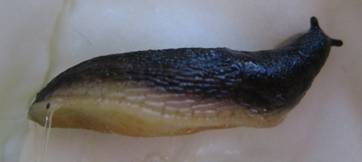 Black Field Slug, Arion hortensis (R.J. Mc Donnell) Black Field Slug, Arion hortensis (R.J. Mc Donnell) |
|
HEDGEHOG SLUG
FAMILY: Arionidae | GENUS and SPECIES: Arion intermedius
The Hedgehog Slug is also native to Europe. It can live up to one year and is the smallest slug in Kentucky, only growing up to 2 cm. This slug is yellowish-gray in color and is named for the raised tubercles on its back which look like spikes when the animal is contracted. The hedgehog slug's head and tentacles are a darker gray than the rest of its body. This slug can be found in gardens, but is more likely to be located in grasslands or agricultural fields. |
| |
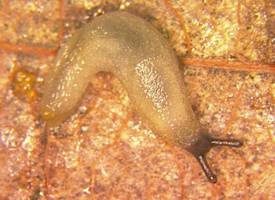 Hedgehog Slug, Arion intermedius (R.J. Mc Donnell)
Hedgehog Slug, Arion intermedius (R.J. Mc Donnell) |
|
|
DUSKY SLUG
FAMILY: Arionidae | GENUS & SPECIES: Arion subfuscus |
|
| The Dusky Slug is native to Europe. It is a very colorful brown and orange slug. This animal can be found along forest edges and occasionally in more residential areas. Dusky slugs can reach 7 cm in length and produce a yellow mucus. |
| |
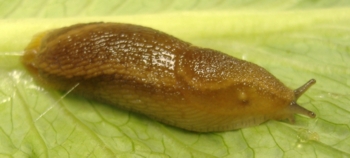 Dusky Slug, Arion subfuscus (R.J. Mc Donnell)
Dusky Slug, Arion subfuscus (R.J. Mc Donnell) |
|
|
|
MARSH SLUG
FAMILY: Agriolimacidae | GENUS
and SPECIES: Deroceras laeve |
|
| The Marsh Slug is one of the most commonly found slugs in Kentucky. It can be found in woodlands, yards, or agricultural fields. It is a translucent grayish-brown slug with a "slimy" appearance. Some populations of this slug species have been in North America so long they are considered native. However, other populations were brought over from Europe more recently. The marsh slug can reach a length of 2.5 cm and is usually found in wet habitats and is a common crop pest. |
| |
 Marsh Slug, Deroceras laeve (R.J. Mc Donnell)
Marsh Slug, Deroceras laeve (R.J. Mc Donnell) |
|
|
GRAY FIELD SLUG
FAMILY: Agriolimacidae | GENUS
and SPECIES: Deroceras reticulatum |
|
| The Gray Field Slug is another European slug that is very common in Kentucky. It is tan with a pattern of dark flecks on its body. The speckled pattern on gray field slugs is variable. Some have so much of the darker pigmentation they are almost black, while others have very little and are very light in color. Gray field slugs can reach a length of up to 5 cm. They can lay 500 eggs per year and are very common in gardens and agricultural areas. They are some of the most destructive slugs in Kentucky. |
| |
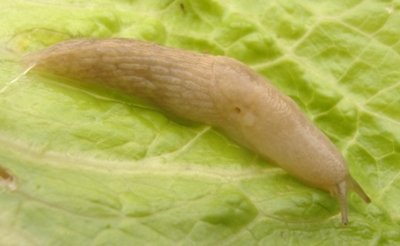 Gray Field Slug, Deroceras reticulatum (R.J. Mc Donnell)
Gray Field Slug, Deroceras reticulatum (R.J. Mc Donnell) |
|
|
THREE-BANDED GARDEN SLUG
FAMILY: Limacidae | GENUS
and SPECIES: Lehmannia valentiana |
|
| The Three-Banded Garden Slug is a European slug common to gardens and greenhouses. It is light-brown with three thin dark bands running lengthwise down its body. This slug can reach 7 cm in length and is one of the larger slugs in the state. |
| |
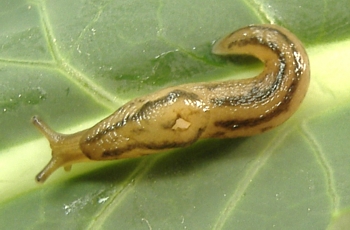 Three-banded Garden Slug, Lehmannia valentiana (R.J. Mc Donnell)
Three-banded Garden Slug, Lehmannia valentiana (R.J. Mc Donnell) |
|
|
GREAT GRAY SLUG
FAMILY: Limacidae | GENUS
and SPECIES: Limax maximus |
|
| This European slug is the largest slug species found in Kentucky. It can be 20 cm long and is an extremely destructive garden pest. Also called the "leopard slug", the Great Gray Slug is brownish-gray with a spotted mantle and stripes or spots all over its body. This species has very elaborate courting behavior and mating pairs will often crawl onto porches at night to breed, leaving behind trails of mucus. |
| |
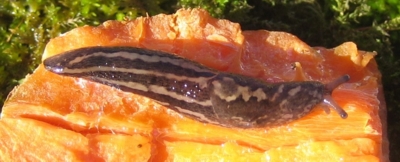 Great Gray Slug, Limax maximus (R.J. Mc Donnell)
Great Gray Slug, Limax maximus (R.J. Mc Donnell) |
|
|
PALLIFERA sp.
FAMILY: Philomycidae | GENUS: Pallifera |
|
| Pallifera is one of only two slug genera native to Kentucky. Members of this genus in Kentucky are relatively small at about 2.5 cm in length. Slugs in this genus can be found in wooded areas, particularly older forests. They are dark gray and have a "slimy" appearance. These animals generally feed on lichen and are not pests, unlike the non-native genera. |
| |
 Pallifera sp.
(R.J. Mc Donnell)
Pallifera sp.
(R.J. Mc Donnell) |
|
|
CAROLINA MANTLESLUG
FAMILY: Philomycidae | GENUS
and SPECIES: Philomycus carolinianus |
|
| The Carolina Mantleslug is another native slug species in Kentucky. They are large slugs and can be up to 10 cm long. The brown and beige mottled mantle of this species covers the entire animal, hence the name mantleslug. This is an inactive species that can be found in wooded habitats, particularly those that are relatively undisturbed. Carolina mantleslugs usually stay hidden under bark or in leaf litter. |
| |
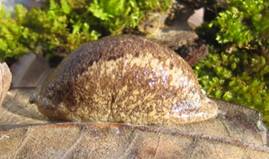 Carolina Mantleslug, Philomycus carolinianus (R.J. Mc Donnell)
Carolina Mantleslug, Philomycus carolinianus (R.J. Mc Donnell) |
|
|
WINDING MANTLESLUG
FAMILY: Philomycidae | GENUS
and SPECIES: Philomycus flexuolaris |
|
| Like the Carolina mantleslug, the Winding Mantleslug is native to Kentucky and can be found under bark, on rotting hardwood, and in leaf litter in undisturbed woodlands. This species can be up to 7.5 cm long with a mantle that covers the entire body of the slug. The winding mantleslug can be distinguished from the Carolina mantleslug, because it has three longitudinal bands on its mantle while the Carolina mantleslug only has two. |
| |
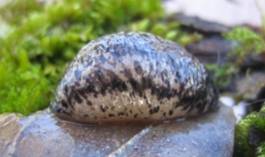 Winding Mantleslug, Philomycus flexuolaris (R.J. Mc Donnell)
Winding Mantleslug, Philomycus flexuolaris (R.J. Mc Donnell) |
|
| |
| COLLECTING
& PHOTOGRAPHY |
|
To find slugs, look underneath logs or in the drainage holes of pots. If it is a humid night, you will probably see them climbing your home or crossing your sidewalk. You can also set traps for them by placing carrot slices under a potting saucer and leaving it overnight. However, be sure to check it early in the morning, since they do not stick around for long after the sun has come up.
Slugs are typically easy to photograph as they do not move too quickly. Since they are often found in dark places, though, you may need a flash or a fast film speed to get a good picture. |
| |
| SLUG
FACTS |
|
Besides keeping the slug moist, slug mucus also has several other functions. It aides in movement by protecting the slug from damage as it travels and it plays a role in courtship and mating. Slugs also use their mucus in defense. Most species of slugs secrete mucus to make it difficult for a predator to hold onto them or to make them taste bad.
Slugs are hermaphroditic, meaning each slug contains both male and female sexual organs. When environmental conditions are harsh, a slug can fertilize its own eggs and therefore does not need to mate to produce young. |
| |
| MYTHS
- LEGENDS - FOLKLORE |
|
Do you know any myths, legends, or folklore about slugs? If you do, please let us know! |
| |
Original document: 20 Apr 2008
Last updated: 20 Apr 2008
Photos courtesy R.J. Mc Donnell, University of California, Riverside
The Kentucky Critter
Files are maintained by Blake Newton, Department of Entomology, University
of Kentucky.
Contact: blaken@uky.edu |
|

